Over the past few years, NFTs have evolved from a small niche into a recognized technology across art, collectibles, and various industries. As interest grows, challenges related to cost and scalability have become more evident, especially for those looking to launch large NFT collections. In response, developers on the Solana blockchain introduced compressed NFTs (cNFTs)—an approach that stores and verifies NFTs in a more resource-efficient way.
We look at what cNFTs are, how they differ from traditional NFTs, and why they may appeal to newcomers and experienced users on Solana.
The Rise of NFTs on Solana
Early NFT Landscape
When Solana first emerged as a platform for NFTs, most collections were relatively small and pricey to mint. Developers championed profile picture (PFP) projects, and early adopters embraced their exclusivity. The idea was to keep supply limited, thus driving up perceived value. However, minting large numbers of NFTs at scale could quickly become costly.
Shift Toward Accessibility
Many artists and community builders found that high fees limited their ability to experiment with large collections or give away free NFTs to fans. Solana’s developers responded by introducing compressed NFTs, which use an innovative approach to store data more efficiently.
This shift toward reduced on-chain storage enables creators to mint hundreds of thousands—or even millions—of NFTs at a fraction of the old cost, making the technology accessible to more people.

What Are Compressed NFTs (cNFTs)?
Core Definition
Compressed NFTs, often called cNFTs, use state compression technology to reduce the amount of on-chain data required for ownership and metadata. Instead of each token occupying substantial space on the blockchain, cNFTs maintain a lean record of ownership, with other details stored off-chain.
How cNFTs Differ from Traditional NFTs
-
Traditional NFTs: Typically store images and metadata either fully on-chain or in external links (like IPFS). This can become expensive at scale because every entry requires blockchain space.
-
cNFTs: Maintain the essential ownership records on-chain but compress and offload the heavier metadata elsewhere. This hybrid design lowers costs while providing a verifiable link to the token.
Key Features
cNFTs slash the costs of minting large NFT collections by storing less data on-chain, allowing creators to launch thousands or even millions of tokens without breaking the bank. This efficiency also helps tackle scalability, making cNFTs an excellent fit for gaming, social media, and metaverse projects that need high-volume assets.
They achieve this balance by keeping essential ownership details on-chain while offloading heavier files elsewhere, preserving authenticity without bogging down the network. Because fewer transactions hit the blockchain, cNFTs lower energy usage, offering a more sustainable path for creators and collectors alike.
How cNFTs Work on the Solana Blockchain
State Compression in Action
Solana’s state compression is the secret sauce behind cNFTs. Instead of writing every bit of data for each token onto the blockchain, the protocol organizes the information using Merkle trees. A compressed record of ownership goes on-chain, while large files (like images or animations) stay off-chain.
In compressed NFTs, the detailed account information isn’t held directly on-chain. Instead, it’s kept in off-chain data stores managed by RPC providers.
By verifying each token’s existence through cryptographic proofs, the system ensures everyone can trust the data without needing to store every detail on the blockchain.
cNFTs have gained traction partly thanks to an expanding toolset. Well-known Solana wallets—Phantom, Solflare, and Backpack—support cNFTs, allowing users to buy, sell, and manage them with minimal friction.
Why cNFTs Matter
Affordability Spurs Innovation
When minting fees are high, creators may hesitate to experiment. Compressed NFTs drop these costs significantly, allowing for artistic or experimental projects without worry of financial loss.
For instance, platforms like DRiP can distribute free or low-cost NFTs to engage communities. As a result, more users—artists, fans, and developers—enter the ecosystem, driving new ideas and larger audiences.
Dynamic and Interactive Experiences
Lower fees don’t just make NFTs cheaper; they also spur interactive use cases. Blockchain game devs can create dynamic items that evolve with gameplay, knowing they can handle massive numbers of tokens. Examples include Dialect, which incorporates cNFTs for collectible in-platform stickers and adds gamified engagement.
Community Building and Attention
NFTs are social as much as they are collectible. By distributing tokens widely and at minimal cost, communities can grow faster. DRiP, for example, uses cNFTs to broaden membership and encourage fan participation. This mix of easy entry and creative engagement can capture attention inside and outside the core NFT community.
Key Marketplaces Supporting cNFTs
Tensor
Tensor is a major NFT marketplace embracing cNFTs, offering both traditional listings and an NFT Automated Market Maker (AMM). This setup functions similarly to Sudoswap on Ethereum, letting users place bids and trade in a liquidity pool.
Magic Eden
When Magic Eden launched in September 2021, it quickly became a key destination for anyone interested in NFTs on Solana. It supports traditional Solana and compressed NFTs (cNFTs), allowing creators to release larger collections without running into high fees. With accessible tools and minimal costs, newcomers can easily list projects, and collectors can explore a steady stream of new drops.

Source Tensorians
cNFT Collections
Tensorians
Among the most prominent cNFT collections is Tensorians, introduced by Tensor. This 10,000-piece collection used airdropped “Tensorian Shards” to let people mint the official tokens. Despite being a compressed NFT release, Tensorians has a market cap of 39,640 SOL—equivalent to about $6.3 million.
Tensorians combined large-scale minting with scarcity and exclusivity, demonstrating that mass minting doesn’t automatically destroy an NFT’s potential for long-term value, as long as a community is actively engaged.
Many creators are drawn to cNFTs to experiment with new formats and themes. Whether big gaming projects or niche artistic endeavors, the market for compressed NFTs continues to grow. Potential collectors might find fresh opportunities in marketplaces like Tensor and Magic Eden, where experimental cNFT projects are regularly launched.
The Other Side of cNFTs
Spam and Hacks
Lower minting costs benefit legitimate creators, but they also attract scammers. Some individuals mint and send cheap, suspicious NFTs to random addresses, hoping recipients click on harmful links. Even if the success rate is low, the near-zero overhead of creating and distributing these spam tokens makes such scams appealing to bad actors.
Staying safe means verifying any unexpected NFT drop or link. Users should be cautious about who they trust or which tokens they interact with, especially when they arrive unannounced.
Over-commoditization of NFTs
While cNFTs excel at opening doors to large collections, the ease of minting can flood the market. This can dilute scarcity, a key factor that originally made NFTs attractive as unique digital assets. If everyone can mint unlimited tokens, then the value proposition for specific collections might suffer.
Future Outlook and Potential
Widening Adoption
As minting costs stay low, it’s likely that more developers, brands, and artists will experiment with cNFTs. With smaller financial barriers, creators can explore fresh ideas with reduced risk, and communities can participate more freely.
Evolving Technologies
State compression is just the start. Ongoing research may refine these strategies, making minting even more efficient or adding features like partial on-chain updates. Other blockchains might also adopt similar approaches as they grapple with the same cost and scalability hurdles.
Over the past few years, NFTs have evolved from a small niche into a recognized technology across art, collectibles, and various industries. As interest grows, challenges related to cost and scalability have become more evident, especially for those looking to launch large NFT collections. In response, developers on the Solana blockchain introduced compressed NFTs (cNFTs)—an approach that stores and verifies NFTs in a more resource-efficient way.
We look at what cNFTs are, how they differ from traditional NFTs, and why they may appeal to newcomers and experienced users on Solana.
The Rise of NFTs on Solana
Early NFT Landscape
When Solana first emerged as a platform for NFTs, most collections were relatively small and pricey to mint. Developers championed profile picture (PFP) projects, and early adopters embraced their exclusivity. The idea was to keep supply limited, thus driving up perceived value. However, minting large numbers of NFTs at scale could quickly become costly.
Shift Toward Accessibility
Many artists and community builders found that high fees limited their ability to experiment with large collections or give away free NFTs to fans. Solana’s developers responded by introducing compressed NFTs, which use an innovative approach to store data more efficiently.
This shift toward reduced on-chain storage enables creators to mint hundreds of thousands—or even millions—of NFTs at a fraction of the old cost, making the technology accessible to more people.

What Are Compressed NFTs (cNFTs)?
Core Definition
Compressed NFTs, often called cNFTs, use state compression technology to reduce the amount of on-chain data required for ownership and metadata. Instead of each token occupying substantial space on the blockchain, cNFTs maintain a lean record of ownership, with other details stored off-chain.
How cNFTs Differ from Traditional NFTs
-
Traditional NFTs: Typically store images and metadata either fully on-chain or in external links (like IPFS). This can become expensive at scale because every entry requires blockchain space.
-
cNFTs: Maintain the essential ownership records on-chain but compress and offload the heavier metadata elsewhere. This hybrid design lowers costs while providing a verifiable link to the token.
Key Features
cNFTs slash the costs of minting large NFT collections by storing less data on-chain, allowing creators to launch thousands or even millions of tokens without breaking the bank. This efficiency also helps tackle scalability, making cNFTs an excellent fit for gaming, social media, and metaverse projects that need high-volume assets.
They achieve this balance by keeping essential ownership details on-chain while offloading heavier files elsewhere, preserving authenticity without bogging down the network. Because fewer transactions hit the blockchain, cNFTs lower energy usage, offering a more sustainable path for creators and collectors alike.
How cNFTs Work on the Solana Blockchain
State Compression in Action
Solana’s state compression is the secret sauce behind cNFTs. Instead of writing every bit of data for each token onto the blockchain, the protocol organizes the information using Merkle trees. A compressed record of ownership goes on-chain, while large files (like images or animations) stay off-chain.
In compressed NFTs, the detailed account information isn’t held directly on-chain. Instead, it’s kept in off-chain data stores managed by RPC providers.
By verifying each token’s existence through cryptographic proofs, the system ensures everyone can trust the data without needing to store every detail on the blockchain.
cNFTs have gained traction partly thanks to an expanding toolset. Well-known Solana wallets—Phantom, Solflare, and Backpack—support cNFTs, allowing users to buy, sell, and manage them with minimal friction.
Why cNFTs Matter
Affordability Spurs Innovation
When minting fees are high, creators may hesitate to experiment. Compressed NFTs drop these costs significantly, allowing for artistic or experimental projects without worry of financial loss.
For instance, platforms like DRiP can distribute free or low-cost NFTs to engage communities. As a result, more users—artists, fans, and developers—enter the ecosystem, driving new ideas and larger audiences.
Dynamic and Interactive Experiences
Lower fees don’t just make NFTs cheaper; they also spur interactive use cases. Blockchain game devs can create dynamic items that evolve with gameplay, knowing they can handle massive numbers of tokens. Examples include Dialect, which incorporates cNFTs for collectible in-platform stickers and adds gamified engagement.
Community Building and Attention
NFTs are social as much as they are collectible. By distributing tokens widely and at minimal cost, communities can grow faster. DRiP, for example, uses cNFTs to broaden membership and encourage fan participation. This mix of easy entry and creative engagement can capture attention inside and outside the core NFT community.
Key Marketplaces Supporting cNFTs
Tensor
Tensor is a major NFT marketplace embracing cNFTs, offering both traditional listings and an NFT Automated Market Maker (AMM). This setup functions similarly to Sudoswap on Ethereum, letting users place bids and trade in a liquidity pool.
Magic Eden
When Magic Eden launched in September 2021, it quickly became a key destination for anyone interested in NFTs on Solana. It supports traditional Solana and compressed NFTs (cNFTs), allowing creators to release larger collections without running into high fees. With accessible tools and minimal costs, newcomers can easily list projects, and collectors can explore a steady stream of new drops.

Source Tensorians
cNFT Collections
Tensorians
Among the most prominent cNFT collections is Tensorians, introduced by Tensor. This 10,000-piece collection used airdropped “Tensorian Shards” to let people mint the official tokens. Despite being a compressed NFT release, Tensorians has a market cap of 39,640 SOL—equivalent to about $6.3 million.
Tensorians combined large-scale minting with scarcity and exclusivity, demonstrating that mass minting doesn’t automatically destroy an NFT’s potential for long-term value, as long as a community is actively engaged.
Many creators are drawn to cNFTs to experiment with new formats and themes. Whether big gaming projects or niche artistic endeavors, the market for compressed NFTs continues to grow. Potential collectors might find fresh opportunities in marketplaces like Tensor and Magic Eden, where experimental cNFT projects are regularly launched.
The Other Side of cNFTs
Spam and Hacks
Lower minting costs benefit legitimate creators, but they also attract scammers. Some individuals mint and send cheap, suspicious NFTs to random addresses, hoping recipients click on harmful links. Even if the success rate is low, the near-zero overhead of creating and distributing these spam tokens makes such scams appealing to bad actors.
Staying safe means verifying any unexpected NFT drop or link. Users should be cautious about who they trust or which tokens they interact with, especially when they arrive unannounced.
Over-commoditization of NFTs
While cNFTs excel at opening doors to large collections, the ease of minting can flood the market. This can dilute scarcity, a key factor that originally made NFTs attractive as unique digital assets. If everyone can mint unlimited tokens, then the value proposition for specific collections might suffer.
Future Outlook and Potential
Widening Adoption
As minting costs stay low, it’s likely that more developers, brands, and artists will experiment with cNFTs. With smaller financial barriers, creators can explore fresh ideas with reduced risk, and communities can participate more freely.
Evolving Technologies
State compression is just the start. Ongoing research may refine these strategies, making minting even more efficient or adding features like partial on-chain updates. Other blockchains might also adopt similar approaches as they grapple with the same cost and scalability hurdles.





















































































rx clomiphene clomiphene for men where can i get clomid clomiphene for sale in mexico clomid rx how can i get clomid can i purchase clomid without insurance
This is the amicable of content I get high on reading.
More posts like this would prosper the blogosphere more useful.
buy generic zithromax for sale – buy cheap generic metronidazole buy metronidazole 200mg without prescription
order semaglutide 14mg generic – buy semaglutide without prescription purchase periactin online cheap
generic motilium 10mg – buy motilium online cyclobenzaprine 15mg pills
propranolol without prescription – order plavix pill methotrexate for sale
amoxiclav order – https://atbioinfo.com/ purchase ampicillin for sale
nexium for sale online – anexamate.com buy generic esomeprazole online
generic warfarin 2mg – coumamide buy cozaar no prescription
buy meloxicam 7.5mg generic – https://moboxsin.com/ buy generic mobic for sale
order generic prednisone – https://apreplson.com/ deltasone 5mg brand
causes of ed – buy ed medication buy ed pill
buy cheap amoxicillin – combamoxi.com amoxicillin without prescription
diflucan oral – flucoan buy diflucan generic
cenforce 100mg canada – https://cenforcers.com/ order cenforce without prescription
pharmacy 365 cialis – https://ciltadgn.com/# great white peptides tadalafil
buy generic ranitidine – this buy zantac 300mg sale
where can i buy viagra online yahoo – https://strongvpls.com/# best price for viagra 100mg
Facts blog you procure here.. It’s severely to assign high calibre writing like yours these days. I truly respect individuals like you! Withstand care!! https://gnolvade.com/
More posts like this would prosper the blogosphere more useful. https://buyfastonl.com/isotretinoin.html
More peace pieces like this would create the интернет better. https://ursxdol.com/doxycycline-antibiotic/
I’ll certainly return to review more. https://prohnrg.com/product/acyclovir-pills/
This is a theme which is in to my fundamentals… Many thanks! Unerringly where can I upon the connection details in the course of questions? https://aranitidine.com/fr/en_france_xenical/
With thanks. Loads of conception!
https://doxycyclinege.com/pro/levofloxacin/
The thoroughness in this draft is noteworthy. http://mi.minfish.com/home.php?mod=space&uid=1411824
purchase forxiga sale – https://janozin.com/# buy forxiga 10mg for sale